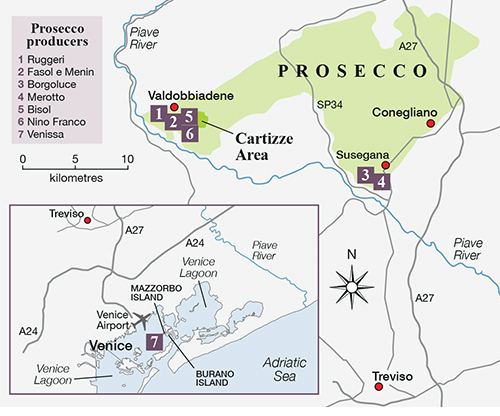Party Prosecco: 12 standout DOC buys
A dozen top pics for parties and beyond...
Prosecco is the Italian sparkling wine produced in the regions of Veneto and Friuli Venezia Giulia, mainly around Conegliano and Valdobbiadene, in the hills north of Treviso.
It is predominantly made from Glera grapes, formerly known also as Prosecco, but other grape varieties such as Bianchetta Trevigiana may be included.
It tends to be quite fruity and flowery and as the wines are produced in large tanks with less pressure, the bubbles are light. Finer versions wines often exhibit notes of tropical fruits, banana cream, hazelnut, vanilla and honeycomb. It is a wedding toast favourite!

The climate is classified as warm and temperate. There is significant rainfall throughout the year, and even the driest summer months still have a lot.
The region is made up of different soils type, but is generally a mixture of limestone, clay, marl and marine sandstone. Together with the temperate climate, it makes it the perfect conditions to grow the Glera grape.
Prosecco has three categories, from driest to sweetest: Brut (including Extra Brut and variously named zero-sugar styles), Extra Dry and Dry.
The lightly sparkling, bottle-refermented Frizzante can be labelled in various ways, but is commonly referred to as ‘col fondo’, meaning ‘with lees’. Since the lees are not removed, the wine is slightly cloudy with a tangy biscuit, citrus and saline quality.
The identification of individual terroir characters has been a theoretical possibility since the Rive sub-zones were introduced in 2009.
Based on administrative boundaries, they were initially viewed as an abstract concept rather than a real guide to terroir, but this could be changing.
Freshness and ripeness are both requirements for making quality Prosecco, and so the best drier styles originate from sitesat higher elevations with greater day-night temperature variations, sometimes on more calcareous soils.
In a radical break from tradition, Brut wines are also starting to appear from Cartizze, which was held in such high regard when production norms were first laid down in 1971 that it was granted its own DOC, and has since been elevated to DOCG status.
Sitting in a natural amphitheatre facing southeast, a high proportion of old vines stand in the calcareous clay and sandy soils of Cartizze. Its superior-quality fruit commanded a premium long before Cartizze gained official recognition.
The wines have long been Dry in the legal sense, with 17-32g/l residual sugar, but Villa Sandi was perhaps the first to break ranks with its genuinely dry, perfumed and richly textured Vigna La Rivetta Brut.
Silvano Follador has followed suit with his Cartizze- sourced Metodo Classico Brut Nature, while Bisol and Garbara make non-dosage Cartizze wines and, in 2018, Ruggeri launched its first edition of a Cartizze Brut.
Quick Links Panel tasting: Best Prosecco Conegliano Valdobbiadenes | Prosecco & Venice: where to stay, eat and shop | Top 10 Prosecco | Prosecco wine tour | Why does my ‘extra dry’ Prosecco taste sweet? – ask Decanter